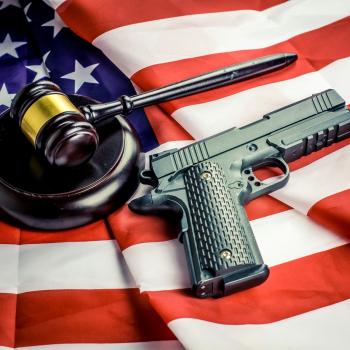My original claim was two-fold: 1. “Liberal” Supreme Court Justices alone are not to be blame for Roe; 2. Republican-appointed Justices over the past 35 years not only were responsible for Roe, but also were responsible for sustaining Roe. I shall expand on the second aspect of my claim in another post. Here I will attempt to diffuse the mist of a revisionist history that deems the 1973 Supreme Court a “liberal” Bench.
To begin, let me reiterate that Roe v. Wade came before a Supreme Court whose make-up was six Republican-appointed Justices and three Democratic-appointed Justices. Of course, nothing precludes a Republican president from nominating a “liberal” Justice, just as nothing precludes a Democratic president from nominating a “conservative” Justice. But that’s theory. I’m interested in the historical reality. The final vote in favor of Roe was 7-2, with five Republican-appointed Justices and two Democratic-appointed Justices in step. Were all five Republican-appointed Justices really “liberals”? Let’s look at each Republican-appointed Justice who voted in favor of Roe to determine whether or not he was discernibly “liberal” when he cast his vote.
Justice Harry Blackmun
Blackmun, who wrote the Majority opinion for Roe v. Wade, was appointed by Richard Nixon. Prior to his Supreme Court appointment, Blackmun was a strong Republican, and he generally was viewed as a conservative by his peers. In 1972 and again in 1976 (three years after Roe), he voted in favor of the death penalty in the cases of Furman v. Georgia and Gregg v. Georgia. In 1971, Blackmun dissented from the Court’s decision in Cohen v. California, which overturned the California Court of Appeals’ decision that wearing a jacket that said “F*ck the Draft” in a courtroom was crime. That same year, he dissented in the New York Times Co. v. United States, arguing against the right of the New York Times to publish classified Pentagon papers. During and in the wake of Roe v. Wade, Blackmun had a track record of conservative positions. It was not until a decade after Roe that Blackmun began to align himself with more liberal policies, and in the mid-1990’s he changed his mind on the death penalty. Notwithstanding his shift to the left in the 1980’s and 1990’s, Blackmun’s political and judiciary views were rather conservative and predictable leading up to, and immediately following, Roe.
Chief Justice Warren Burgher
Burgher, also appointed by Nixon, joined with Blackmun’s lead on Roe. Prior to his appointment to the Supreme Court in 1969, Burgher was a staunch Republican supporter, working on a number of campaigns including Dwight Eisenhower’s. Burgher was a strong critic of the liberal Chief Justice Earl Warren (Eisenhower would later remark that appointing Warren was the biggest mistake of his presidency), and was viewed as a strict, constructionist Justice. Though he worked against segregation, his views on the death penalty were quite conservative and were on display in his dissent from Furman v. Georgia, which sought to invalidate capital punishment. He voted to reinstate the death penalty in 1976 with Gregg v. Georgia. Into the 1980’s Burgher remained conservative on his views of gay rights, upholding the criminalization of sodomy, and on his views of crime and punishment, dissenting in the case of Solem v. Helm. Apart from his support for Roe, Burgher’s tenure as Chief Justice was remarkably uncontroversial and moderately conservative.
Justice William Brennan
Brennan, who was appointed by Dwight Eisenhower, was a Democrat placed on the Court in order to help with Eisenhower’s reelection bid in 1956. A known liberal since his time on the Warren Court, it was not surprising that he joined Justices William Douglas and Thurgood Marshall in supporting Roe.
Justice Potter Stewart
Stewart, who was also appointed by Eisenhower, grew up in a Republican home (his father was the conservative mayor of Cincinatti and a justice on the Ohio Supreme Court). He was known as a moderate and a dissenter within the more liberal Warren Court, arguing that its interpretation of First, Fifth and Fourteenth Amendment rights extended beyond the intentions of their framers. He supported the invalidation of the death penalty under Furman v. Georgia in 1972, but then led the Majority in reinstituting its use under Gregg v. Georgia in 1976. Stewart’s voting record remained moderate throughout his tenure on the Court, though he dissented far more in the liberal Warren Court than in the centrist Burgher Court.
Justice Lewis Powell
Powell, appointed by Nixon, had a solid reputation as a moderate Justice, often seeking consensus and supplying the “swing vote.” In Regents of the University of California v. Bakke in 1978, he was alone in providing an compromise opinion that some affirmative action policies should be struck out and that there were others that could be consitutional. In Bowers v. Hardwick, Powell was the “swing vote” that upheld Georgia’s anti-sodomy laws. Powell’s record on the Supreme Court is remarkably centrist and, one might argue, one of appeasement.
—
I encourage a study far more comprehensive and indepth than my meager summary here. But there is no question that the notion that the 1973 Supreme Court that ruled in favor of Roe was “liberal” does not stand up to historical scrutiny. Blackmun and Burgher were conservatives in 1973 (the former defecting left in the 1980’s and 1990’s), and Stewart and Powell were moderates. Brennan is the only Republican-appointed Justice of the Roe Court who was truly a liberal.
No matter how one slices it, the Supreme Court in 1973 had three (Brennan, Marshall, Douglas), arguably four (Stewart), “liberal” justices. That is not a majority, and it certainly does not explain why and how seven Justices pulled in favor of Roe. Bottom line, conservative and moderate Justices joined with liberal Justices to rule in favor of Roe, and of the five Republican-appointed Justices among them, only one can truly be labelled a “liberal.”












